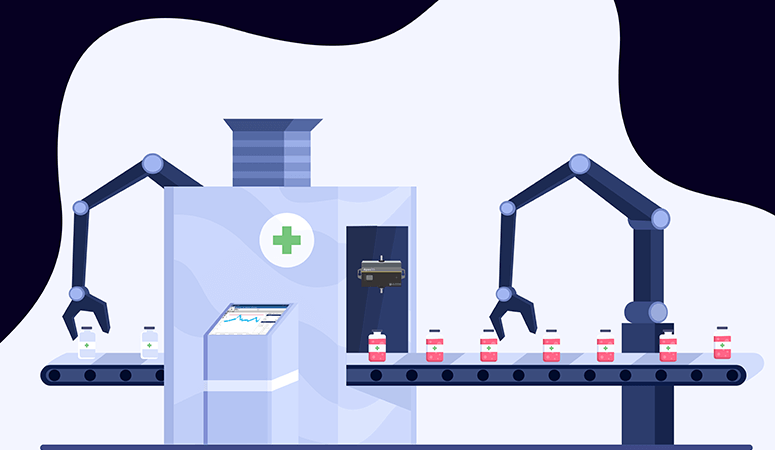For years now, robots and automation have been making their way into pharmaceutical production. Lately, though, the power of Artificial Intelligence (AI) has taken the world by storm in the form of ChatGPT: a uniquely human AI bot that will have conversations with you, research for you, and adapt to what you ask it to do. In education circles, this has raised questions about AI making it easier to cheat. In marketing circles, writers have praised the ease ChatGPT has brought to content creation. But in the pharmaceutical industry, AI is old news.
That is not to say robotics, automation, and AI will not continue to evolve and impact pharmaceutical manufacturing, especially as we enter Pharma 4.0. Essentially, Pharma 4.0 is the pharmaceutical industry’s version of Industry 4.0: the fourth industrial revolution. The first industrial revolution involved mass manufacturing, the second revolved around scientific discovery and technology, and the third revolution was spurred by communication technology. Now, the fourth revolution is being pushed by AI and automation, with an emphasis on information availability, employee autonomy, and, of course, digitization.
So what impact does automation and robotics have on Pharma 4.0? Let’s take a look at where they’ve impacted the industry – and where they’re going.
Maintaining Regulatory Compliance
Pharmaceutical manufacturing is just one of the many industries subject to those three letter agencies and their regulations. Maintaining regulatory compliance can be extremely challenging, especially if you are primarily relying on humans for data management. When following ALCOA+, the FDA’s data integrity standards, all data should be carefully accounted for, including dates, times, and responsible person’s, as well as collection consistency.
Today, many robots and other automation tools are built with compliance in mind. They track their actions, automatically creating records of the data and its generation methods. If they are designed with ALCOA+ in mind, they will prompt users to enter their credentials and note critical times and dates.
But that’s just the record keeping side of it. Automation and robots also help keep humans physically out of the cleanroom.
Regulatory authorities are updating their guidelines as we step into Pharma 4.0 – and keeping technology and automation at the forefront of the safety of the end user. A prime example of this is the recent update to GMP Annex 1. In this update, an emphasis is placed on removing humans from the cleanroom and implementing automation wherever possible. This keeps processes more consistent and reduces risk contamination.
Maximizing Return On Investment (ROI)
Ultimately, robots, AI, and automation tools are more affordable than humans when it comes to completing mundane tasks, such as packaging, labeling, filling, and sealing. Until the robots take over the world, humans will still be needed to ensure cleanrooms are running correctly. But freeing employees of trivial tasks that are easily automated and handed over machines not only improves accuracy and increases productivity, it allows the human mind to do what it does best and innovate. Create. Explore. Imagine.
A robot will only do what it is told to, but your employees’ uniquely human minds will take your organization to the next level. They are your most valuable asset and deserve the time to explore what makes them unique. That is how you can maximize your ROI with your employees: let them help you grow. And that is how humans will be most valued in Pharma 4.0.
Improving Traceability
When a robot or AI tool does something, it automatically creates a record of it. Changes to SOPs are noted and tracked along with everyday operations. We’ve already covered the way automation can help with regulatory compliance, but improved traceability can help you in more ways than just compliance.
For example, if you are having a routine problem with under-filling, being able to trace multiple variables, such as personnel and equipment involved, can help you track down the root of the problem. In another scenario, you might be experiencing regular contamination incidents. Tools that help you track movement in your cleanroom as well as the exact moment of contamination could point you towards your culprit, whether it is a rusted robot or an employee who needs a refresh on their gowning training.
This kind of traceability, compliance, and integration of digital assets into your cleanroom epitomizes Pharma 4.0.
Reducing Downtime
In a shocking (not-so-shocking) turn of events, humans require sleep. When the mundane tasks of pharmaceutical manufacturing are passed to robots, cleanrooms can run up to 24 hours a day. While you increase your risk of downtime due to machine failure, simply by introducing more machines to your production line, you overall increase your cleanroom’s capacity for uptime.
Decreasing Time To Market
When pharmaceuticals are in development, robots and automation can help rapidly conduct tests, allowing the R&D team the freedom to move forward quickly. AI can even help researchers conclude where something might have gone wrong and prompt how to move forward. The automation of development will lead the way for innovation and rapid production in Pharma 4.0.
What Comes Next?
As we embrace Pharma 4.0 and the power of digitization, what comes next? Where do we go from here? How do we make sure our cleanrooms are following best practices and fully utilizing technology?
We answer all that – and more – in the regular updates we make to our Knowledge Center. This is the (free!) hub for all things cleanroom, environmental monitoring, industry updates, regulation breakdowns, and more. We take the complex topics we face every day, filter it through our experts, and publish easy-to-digest articles and videos to help you stay informed.


